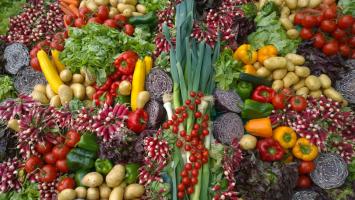
AYURVEDA PHARMACOLOGY OF FOOD & HERBS
CLASSIFICATION OF FOOD, HERBS, & LIFESTYLE
NUTRIENTS USED ON JOYFUL BELLY
Natural Law Theory
to match food, herbs, and lifestyle choices to specific imbalances
for effective treatment options and alternative approaches. In Ayurveda, this system is called Dravya Guna Shastra.
This system suggests that different foods have different characteristics,
and consuming the right foods can help to balance the metabolic characteristics (i.e. three doshas Vata, Pitta, and Kapha) of the body.
Dravya-Guna-Shastra forms the foundation of Ayurveda's pharmacology.
The system of Dravya-Guna-Shastra is biocharacteristics based,
sharing many features with Unani Tibb and Greek Medicine.
A theory that things have a true nature or form that they realize imperfectly.
For example, an imperfectly drawn triangle has a true nature to be a perfect triangle.
Imperfections of the human form arise from genetics, poor lifestyle and diet choices, or environment. The imperfections themselves have a nature which corrupts the human nature. Ayurved classifies these imperfections into various biocharacteristics or gunas. Natural Law Theory is a basic view of reality first described by Aristotle and later developed in the Middle Ages. It differences from the modern mechanistic view of reality, which claims that things do not have a nature beyond the sum of their parts. On Joyful Belly, we've integrated this system into the core of the website, to provide tools for modern clinicians. Please click on category below to see how remedies are classified under this system. See all categories 5A-REDUCTASE-INHIBITOR
Group: Male-Health ALKALOIDS
ALPHA-LINOLENIC-ACID
Group: Heart-Circulation-Blood ANTHOCYANINSAnthocyanins are a type of polyphenol. As all polyphenols, they have a strong antioxidant effect. ANTHRAQUINONEActs as a colon stimulant laxative and osmotic stool softener. Stimulates inflammatory prostaglandins in the colon. Calcium channel blocker that relaxes smooth muscle tissue. It is the active ingredient in senna, turkey rhubarb, cascara sagrada, etc. Group: Bowel-Poop-Elimination AROMATASE-INHIBITORBlocks estrogen synthesis by inhibiting conversion of progesterone and testosterone into estrogen. Group: Reproductive-Health BERBERINEA bitter compound having strong chologogue, alterative, and anti-microbial properties. Lowers dopamine. Group: Liver-Gallbladder BETA-CAROTENE
BETAINEUsed to reduce homocysteine in the blood, which supports proper liver function and prevents fatigue and blood clots. Improves muscle stamina and weight loss. Group: Liver-Gallbladder CAFFEINE-METHYLXANTHINESMethylxanthines are purine alkaloids that have a stimulant and bronchodilating effect. Group: Energy-Vitality CALCIUMCalcium nourishes bones and muscles. A muscle cell is activated when calcium enters the cell. It relaxes when the calcium is secreted. CAPRYLIC-ACID
Group: Immune-System CARBOHYDRATE
CARDIAC-GLYCOSIDESCardiac glycosides disrupt the sodium potassium pump, causing stronger heart contractions. Group: Heart-Circulation-Blood CARNITINE
Group: Muscle-Health CATECHINSAntioxidant that reduces cancer and blood clots, dilates blood vessels, and is antimicrobial. Group: Heart-Circulation-Blood CHOLINEPrecursor to acetylcholine. Essential nutrient that supports liver and brain development, metabolism, and muscle and nervous system function. It is lipotropic (aiding fat metabolism in the liver). Group: Liver-Gallbladder COPPER
Group: Energy-Vitality COQ10CoQ10 is a coenzyme that aids in ATP production in mitochondria. It is especially present in muscles, and energizes muscles. It is often used in heart weakness and low energy. Group: Energy-Vitality COUMARINModerately toxic, vascular tonic, hypotensive, and anti-inflammatory. Group: Heart-Circulation-Blood EMODINEmodin is an antifibrotic molecule found in many anthroquinone laxatives. Group: Skin-Care EPHEDRA
Group: Mind-Stress-Sleep ESSENTIAL-FATTY-ACIDS (EFA)
Group: Heart-Circulation-Blood ESSENTIAL-OIL
FATS
FLAVONOIDS (AKA BIOFLAVANOIDS)Flavonoids are a colorful type of polyphenol. As all polyphenols, they have a strong antioxidant effect. Many flavonoids have an anti-inflammatory, and/or antiallergen effect. Group: Heart-Circulation-Blood FOLATE
FOLIC-ACID
Group: Heart-Circulation-Blood GAMMA-LINOLENIC-ACID (GLA)
Group: Immune-System GLUTAMINE
Group: Digestion GLUTATHIONE
Group: Immune-System HYDROLYSABLE-TANNINSDo not use internally - breaks down to caustic, hepatotoxic elements in the body. Group: Heart-Circulation-Blood INOSITOLInositol is an alcohol sugar made naturally in the human body from glucose. It is lipotropic (aiding fat metabilism in the liver). It affects a variety of hormones, neurotransmitters, steroid, growth factors and water. Group: Reproductive-Health INSOLUBLE-FIBER
INULIN
Group: Digestion IODINE
IRONIron is necessary for the transport of oxygen in red blood cells. ISOFLAVONEA type of naturally occurring isoflavonoid. Many have a phytoestrogen effect. Frequently found in the pea family (Fabaceae). LYSINE
MAGNESIUMHelps muscles relax. Laxative. MANGANESE
MEDIUM-CHAIN-TRIGLYCERRID
Group: Mind-Stress-Sleep MELATONIN
Group: Mind-Stress-Sleep NITRIC-OXIDEImproves circulation by dilating blood vessels. Protects blood vessels from damage. Improves athletic performance, libido, immunity, and brain health. Group: Heart-Circulation-Blood OMEGA-3-FATTY-ACIDS
OMEGA-6-FATTY-ACID
Group: Immune-System PHOSPHOROUS
PHYTATESPhytates prevent absorption of nutrients. They are commonly found in all seeds, including nuts, grains, and beans. Sprouting greatly reduces phytate content, as well as long, slow cooking with vinegar. Group: Digestion PHYTOSTEROLSThe plant version of cholesterol. Often precursors to stress and sex hormones. Group: Reproductive-Health POLYPHENOLSPolyphenols are powerful antioxidants seen in many fruits and vegetables. There are more than 8,000 types. POLYSACCHARIDES
Group: Immune-System POTASSIUM
PROBIOTIC
Group: Digestion PROTEIN
QUERCITIN
Group: Heart-Circulation-Blood RESISTANT-STARCH
Group: Cleanse-and-Detox RESVERATROLAntioxidant frequently used for anti-aging. Protects airways and blood vessels. Anti-inflammatory and anti-diabetic. Group: Skin-Care ROSMARINIC-ACIDInhibits autoantibodies from binding to TSH receptors in the thyroid. Group: Immune-System RUTINRutin is a flavonoid with anti-oxidant, anti-inflammatory and anti-cancer properties. Commonly used to treat conditions such as varicose veins, hemorrhoids, and high blood pressure. Group: Heart-Circulation-Blood SAPONINSCan be used to make soap. Saponins stimulate mucus membrane secretion, liquefying mucus for easy removal (expectorant). Group: Respiratory-Health SELENIUM
SESQUITERPENES
SILICA-SALTS
Group: Kidney-Bladder-Urinary SODIUM
SOLUBLE-FIBER
STEROIDAL-SAPONINSSteroidal saponins closely resemble human hormones such as estrogen and cortisol, and have a hormonal activity in the body. SULFATED-POLYSACCHARIDES
Group: Skin-Care SULPHUR
Group: Skin-Care TANNINS
TAURINETaurine regulates potassium, calcium and sodium in the blood which normalizes blood pressure, and proper nerve and muscle function. It is also anti-inflammatory. Group: Heart-Circulation-Blood TRITERPENE-SAPONINSTriterpene saponins are generally expectorant and increase absorption. They irritate mucus membranes and are mucolytic. They bind to and reduce cholesterol, and detoxify by binding to bacterial edotoxins. TYROSINE
Group: Energy-Vitality VITAMIN-A
VITAMIN-B-GENERALB vitamins general help in metabolism, fat metabolism (lipotropic), and red blood cell synthesis. Group: Liver-Gallbladder VITAMIN-B12An enzyme in every cell of the body, that aids metabolism, fat & protein metabolism, and DNA synthesis. B12 comes from animal course, and is commonly deficient in vegetarians. VITAMIN-C
VITAMIN-D
Group: Bone-Joint VITAMIN-E
VITAMIN-K
ZINC
|
Join Joyful Belly.
Want our top Ayurvedic recipes and health tips?Subscribe to our free newsletter!









